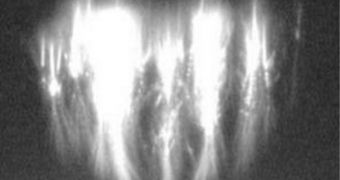According to a new scientific investigation, it may be that our planet's atmosphere is capable of forming massive energy fields high above Earth's surface that act just like particle accelerators. The conclusions were presented today, April 14, at the Royal Astronomical Society (RAS) National Astronomy Meeting (NAM 2010), held in Glasgow, Scotland. The work was conducted by Dr. Martin Fullekrug, an expert who holds an appointment as a lightning researcher at the University of Bath.
He told colleagues that the particle accelerator-like formations appear some 40 kilometers above the surface, during massive thunderstorms. The structures themselves form well above the clouds, but only when the right set of conditions is met. This means that they appear only when powerful electrical discharges (lightnings) are triggered at the same time as cosmic rays enter the atmosphere. These are very high-energy particles coming in from all corners of the Universe. Most of them are stopped by the planet's magnetosphere, but some manage to get through, ScienceDaily reports.
The expert explained that cosmic rays have so much energy that they can basically pull electrons from the atoms in air molecules. If this happens at the same time a lightning bolt discharges, then the electric field produced accelerates the electrons upwards, essentially producing a linear particle accelerator. As the electrons move upwards, they navigate through the troposphere all the way to the edge of space, where radiation belts trap them. This is very dangerous for satellites that circle the planet in a low-Earth orbit, as they excess electrons that can fry their sensitive electrical equipments and scientific instruments.
The electrons move in highly-focused beams as they accelerate, and Fullekrug said that their energy can be compared to that of a small nuclear power plant. Using advanced computer simulations, run at the US Department of Energy's (DOE) Los Alamos National Laboratory (LANL) supercomputer facility, expert Dr. Robert Roussel-Dupre managed to infer that the natural electron beams could be detected by the radio signature they emit as they go up. The prediction held up to scrutiny, when the two researchers, helped by science teams from Denmark, France, Spain and the UK, succeeded in isolating the signatures.
“It's intriguing to see that nature creates particle accelerators just a few miles above our heads. Once these new missions study them in more detail from space we should get a far better idea of how they actually work. They provide a fascinating example of the interaction between the Earth and the wider Universe,” Fullekrug said at NAM 2010.

 14 DAY TRIAL //
14 DAY TRIAL //